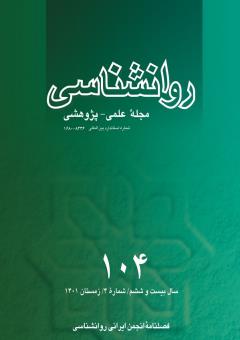خصوصیات روانسنجی نسخه فارسی پرسشنامه مدل شش عاملی اهداف پیشرفت دانشآموزان دوره اوّل و دوّم متوسطه
محورهای موضوعی : روانشناسی
محسن آربزی
1
![]() ,
محبوبه فولادچنگ
2
,
محبوبه فولادچنگ
2
1 - گروه روانشناسی تربیتی، دانشکده علوم تربیتی و روانشناسی، دانشگاه شیراز، شیراز، ایران.
2 - گروه روانشناسی تربیتی، دانشکده علوم تربیتی و روانشناسی، دانشگاه شیراز، شیراز، ایران.
کلید واژه: اهداف پیشرفت, اعتبار, روایی, دانشآموزان,
چکیده مقاله :
هدف پژوهش حاضر تعیین ویژگیهای روانسنجی پرسشنامه اهداف پیشرفت الیوت و همکاران (2011) در دو گروه دانشآموزان مقطع متوسطه اوّل و مقطع متوسطه دوّم بود. جهت بررسی روایی و اعتبار این پرسشنامه در گروه دانشآموزان دوره اوّل متوسطه، 279 نفر از دانشآموزان این دوره در شهرستان اوز واقع در جنوب استان فارس که در سال تحصیلی 1400-1399 مشغول به تحصیل بودند به روش نمونهگیری در دسترس انتخاب شدند و به نسخه الکترونیکی پرسشنامههای اهداف پیشرفت (الیوت و همکاران، 2011) و انگیزه درونی (چوی و همکاران، 2010) پاسخ دادند. همچنین، برای بررسی روایی و اعتبار این ابزار در گروه دانشآموزان دوره دوّم متوسطه، 420 نفر از دانشآموزان این دوره در همان شهرستان و سال تحصیلی با استفاده از روش نمونهگیری در دسترس انتخاب شدند و به نسخه الکترونیکی پرسشنامههای اهداف پیشرفت (الیوت و همکاران، 2011)، خودتنظیمی تحصیلی (پینتریچ و دیگروت، 1990) و درگیری تحصیلی (ریو، 2013) پاسخ دادند. دادهها با استفاده از نرمافزارهای آماری SPSS-16 و AMOS-21 تحلیل شدند. روایی محتوایی، سازه و همگرا پرسشنامه مذکور به ترتیب با استفاده از نظر متخصصان روانشناسی تربیتی، تحلیل عاملی تأییدی و ضرایب همبستگی نمرات مؤلفهها با متغیرهای مرتبط مورد بررسی قرار گرفت. بهمنظور بررسی اعتبار پرسشنامه از ضریب آلفای کرونباخ استفاده گردید. متخصصان معرف بودن مادههای پرسشنامه را برای سنجش اهداف پیشرفت موجود در مدل 6 عاملی ارائه شده توسط الیوت و همکاران (2011) تأیید کردند. آزمون مدل اهداف پیشرفت شامل مؤلفههای تکلیفگرایی، تکلیفگریزی، خودگرایی، خودگریزی، دگرگرایی و دگرگریزی تأییدکننده ساختار شش عاملی این پرسشنامه همسو با پژوهش اصلی است. همچنین ارتباط منطقی مؤلفههای اهداف پیشرفت با متغیرهای مرتبط از روایی همگرای این پرسشنامه حکایت دارد. علاوه بر آن ضرایب آلفای کرونباخ تأییدکننده اعتبار پرسشنامه است. در مجموع، یافتههای پژوهش نشان میدهد که نسخه فارسی پرسشنامه مذکور از شاخصهای روانسنجی مناسبی برای اندازهگیری 6 مؤلفه اهداف پیشرفت در دو گروه دانشآموزان دوره اوّل و دوّم متوسطه برخوردار است و کارایی لازم را برای اندازهگیری اهداف پیشرفت دارد.
The aim of the present study was to investigate the psychometric properties of the six-factor model of achievement goals questionnaire (Elliot et al., 2011) in the students of the junior and senior high schools. In order to investigate the validity and reliability of the achievement goals questionnaire in the junior high school students, 279 students in Evaz city (in the south of Fars province) who were studying in the academic year of 2020-2021, were selected by convenience sampling method and responded to the electronic version of the questionnaires of achievement goals (Elliot et al., 2011) and intrinsic motivation (Choi et al., 2010). Also, in order to investigate the validity and reliability of this questionnaire in the second group, 420 students were selected in the same city and academic year using the convenience sampling method and responded to the electronic version of the questionnaires of achievement goals (Elliot et al., 2011), academic self-regulation (Pintrich & DeGroot, 1990) and academic engagement (Reeve, 2013). Data were analyzed using SPSS-16 and AMOS-21 statistical software. The content, construct and convergent validity of the mentioned questionnaire were investigated using the opinion of educational psychology experts, confirmatory factor analysis and correlation coefficients of the component scores with related variables. Cronbach's alpha coefficient was used to investigate the reliability of the questionnaire. Experts confirmed the representativeness of the questionnaire items to measure the achievement goals in the six-factor model presented by Elliot et al. (2011). The achievement goals model test includes the components of task-approach, task-avoidance, self-approach, self-avoidance, other-approach, and other-avoidance, confirming the six-factor structure of this questionnaire according to the primary research. Also, the logical connection between the components of achievement goals with related variables indicates the convergent validity of this questionnaire. In addition, Cronbach's alpha coefficient confirms the reliability of the questionnaire. In total, the findings of the research show that the Persian version of the mentioned questionnaire is one of the suitable psychometric indicators for measuring the six components of achievement goals in two groups of students of the junior high school and senior high school students; And it has the necessary efficiency to measure the mentioned achievement goals.
